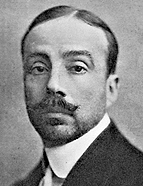

José de Figueiredo began his career as a writer on "art matters" with works in which he demonstrated his knowledge of the themes and debates then in vogue both in Portugal and abroad. In his first major works— Portugal na Exposição de Paris (1901), O legado Valmor e a reforma dos serviços de bellas-artes (1901), and Arte e artistas contemporâneos (1905) [Contemporary art and artists]— he criticised the denationalisation of Portuguese art due to the influences taken by artists during their training abroad and the lack of a historical memory and a sense of heritage. He defended naturalism in painting as a fundamental means of spreading a "Portuguese-ness" that could be lost among the younger generations trained in French and Italian schools. Also, he called for the defence of local artistic industries, such as lace, ceramics, foundry and goldsmithing. His duly recognised influences in these texts were the works of Sousa Viterbo, António Augusto Gonçalves, Joaquim de Vasconcelos and Ramalho Ortigão. This last author was, in this period, the main influence on his critical thinking, which at the time was marked by a rhetoric linked to a fatalistic announcement of the tendency towards "denationalisation" and the de-characterisation of Portuguese art, so proclaimed by that scholar. However, Figueiredo progressively moved away from this stance, taking on a more positive and exalting attitude towards "being Portuguese". This is evident in Algumas palavras sobre a evolução da arte em Portugal (1908) [Some thoughts on the evolution of Portuguese art], a work that Reinaldo dos Santos classified as a "broad fresco which values and characterizes the current of national sentiment" (Reinaldo dos Santos, Homenagem à memória do Dr. José de Figueiredo… 1938 [Tribute to the memory of José de Figueiredo], p. 15).
His role as an art historian was consolidated with the publication of Arte portuguesa primitiva. O pintor Nuno Gonçalves (1910). In this work, which takes into account previous studies by Athanazius Raczynski, John Charles Robinson, Sousa Holstein, Joaquim de Vasconcelos, and Herbert Cook, Figueiredo identifies the author of the panels (Nuno Gonçalves), suggests a dating (between 1459 and 1464) and puts forth that they should belong to a "national school" of 15th century painting— the school of the so-called "Portuguese primitives" who, although Flemish in origin, had their own technical and aesthetic originality that set them apart from the rest of European painting from that period. His historiographical activity was part of an international framework marked by the intensification of studies on the art of the early European Renaissance and by theses aimed at affirming the specificities and autonomy of the "local schools" in relation to the established Italian school, and had two major sources of influence: Positivism, especially the current defended by Hippolyte Taine, which was based on the idea that the conditioning factors of race, environment and time had strong implications for the emergence and development of human phenomena, such as art; and the theories defended by Louis Courajod and his disciples who, developing the ideas announced by Taine, built a historiographical vision based on the study of racial factors and local specificities as determinants of artistic styles, which resulted in the identification of numerous artistic schools that, when integrated into wider contexts, presented singularities worthy of being studied and valued. At the same time, Figueiredo is aware of the renewed interest in the so-called "minor" arts (decorative arts), which since the end of the 19th century were beginning to be studied in depth and integrated into art historiography. In this field, he was interested in the contact relations between Portuguese art and "overseas" art, especially in expressions such as ceramics, furniture, jewellery, tapestries, etc. It should also be noted that the themes he tackled throughout his career reflected the need to study the MNAA's growing collections and the countless old paintings coming from various other institutions into the museum's restoration workshop for restoring.
This work is financed by national funds through FCT - Foundation for Science and Technology, I.P, in the scope of the projects UIDB/04311/2020 and UIDP/04311/2020.
